Abstract
Potato psyllid (Bactericera cockerelli) is one of the most important pests in potatoes (Solanum tuberosum L.) due to its feeding behavior and the transmission of a bacterium (Candidatus Liberibacter solanacearum) that causes zebra chip disease, altering the quality of the potato tuber and the fried potato chip or french fry. This pest is thus a threat to the chip potato industry and often requires preventive measures including the use of costly insecticides. The objectives of this research were to monitor the variation in B. cockerelli adult abundance and to evaluate the risk of zebra chip disease in northwestern New Mexico, USA. Yellow sticky traps were used to collect the pest at the Agricultural Experiment Station at Farmington, NM and in nearby commercial fields at the Navajo Agricultural Products Industry (NAPI) and Navajo Mesa Farms during the 2017–2019 period. The collected adult pests were analyzed at Texas A & M University for the presence of Candidatus L. solanacearum (Lso). The results showed field infestation by B. cockerelli in early June and that the population peaked during the second half of July and decreased as the potato growing season progressed. However, a second less important peak of the pest was revealed around mid- to late-August, depending on the growing season and field. While the B. cockerelli population increased linearly with average air temperature, it showed strong third order polynomial relationships with the accumulated thermal units and the Julian days. The test of B. cockerelli for the Lso infection revealed a low incidence of the pathogen varying from 0.22% to 6.25% and the infected adult B. cockerelli were collected during the population peak period. The results of this study may be helpful to potato growers in pest management decision-making and control. However, more study is needed to evaluate zebra chip disease in terms of its prevention and economic impact, and to develop economic thresholds and pest management programs for northwestern New Mexico and neighboring regions.
1. Introduction
The potato psyllid, Bactericera cockerelli (Šulc; Hemiptera: Triozidae), is one of the most economically important pests for potato (Solanum tuberosum L.) production in North America [1,2]. Potato psyllids feed on the underside of leaves and suck within the potato vascular system, causing leaf chlorosis that impacts tuber yield of the potato crop [3]. Most importantly, B. cockerelli is recognized as a vector of the pathogenic bacterium, Candidatus Liberibacter solanacearum (Lso), also called Ca. Liberibacter psyllaurous, which causes the zebra chip disease [3,4,5,6,7,8].
Potato psyllid is indigenous to northern Mexico and the southwestern United States and migrates north mostly when climatic conditions are favorable [9,10]. Native and planted host plants of potato psyllid are mostly Solanaceae, Convolulaceae and Menthaceae families [11,12]. B. cockerelli has been found in Texas, Nebraska, Colorado, Kansas, California, New Mexico [13,14,15,16,17], Idaho, Washington, Oregon [6,18,19], Minnesota, Wisconsin, and North Dakota [20]. The population dynamics of B. cockerelli abundance vary spatially and temporally across the infested environment [16,21]. Using yellow sticky traps to capture the adult potato psyllid, Wenninger et al. [21] reported that B. cockerelli appeared in late May–early June and the population showed two peaks annually with the greatest peak in late August corresponding to the accumulated degree days of 1775 and 1498 °C in the Treasure and Magic valleys, respectively, in Idaho. Horton et al. [22] reported the first detection of the potato psyllid in small numbers during the last week of May and a significant peak in the late season in Idaho, Oregon and Washington, while it used to appear in the potato field in late June or early July in these states [23,24]. Swisher et al. [25] found the potato psyllid in Farmington (NM) to be native to northwestern New Mexico and that the decline in its population in late growing season might be due to unfavorable weather conditions, basically cold temperatures [17].
Crop production in northwestern New Mexico is entirely irrigated through river diversions distributed among the agri-business company Navajo Agricultural Products Industry (NAPI) and hundreds of small-scale producers. The NAPI farm is irrigated through the Navajo Indian Irrigation Project (NIIP) canal on a mesa top south of Farmington, NM and consists of more than 30,000 ha of cropland equipped with center pivot irrigation systems. The main crop species produced by NAPI are alfalfa, corn, wheat, beans, pumpkins and potatoes. Table stock potato cultivation represents a large part of the production system within the NAPI farm. Navajo Mesa Farms is a contractor producing exclusively chip potatoes on several hundred hectares of land leased from NAPI, having considerable impact on the chip potato industry. While the best agricultural practices are adopted to optimize resource efficiencies under potato production, insect pests could constitute a serious problem as most dangerous phytophagous ones are usually located at the lower side of potato leaves, reducing the efficacy of the contact insecticides [23,26,27]. More importantly, some pests are vector disease carriers with detrimental effects on potato yield and the physical and nutritional quality of the harvested potato tuber, including the zebra chip diseased transmitted by B. cockerelli to the potato plant. The monitoring of the B. cockerelli population and its dynamics through the potato growing season will help in timely control and management of the pest. The objectives of this study were to monitor the population dynamics of the potato psyllid and to test the captured psyllids for their associated pathogen Candidatus Liberibacter solanacearum (Lso), which represents the risk of zebra chip disease in northwestern New Mexico.
2. Materials and Methods
The current study was conducted at the New Mexico State University (NMSU) Agricultural Science Center at Farmington (Latitude 36.69′ North, Longitude 108.31′ West, Elevation 1720 m) (Figure 1a,b). The NMSU Agricultural Science Center is located within the NAPI farm and a part of this study was conducted in NAPI’s plots during the 2017 to 2019 growing seasons. NAPI grows table potatoes while the chip potatoes are grown by Navajo Mesa Farms, a contractor within NAPI. Weather variables were monitored at the experimental station by an automated weather station. Monthly average weather conditions for 2017, 2018, and 2019 are summarized in Table 1.
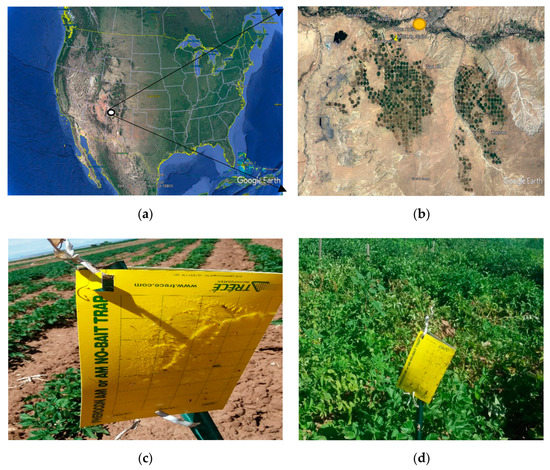
Figure 1.
(a) Field locations of psyllid trapping at Farmington in Northwest New Mexico (white circle) in which (b) green circles represent the Navajo Agricultural Products Industry farms (Center pivot irrigated fields) where NAPI grows table potatoes and other different crops and Navajo Mesa grows chip potatoes; the yellow circle represents location of NMSU experiment station; (c,d) show sticky trap during the early season and the late season, respectively, with difference in vine development.

Table 1.
Weather conditions during the 2017–2019 period at NMSU Experiment Station at Farmington.
Insect traps used for the current study were standard unbaited yellow sticky traps (Trécé Pherocon AM) (Trécé Inc., Adair, OK, USA). The sticky traps were used for the direct monitoring of potato psyllids (Bactericera cockerelli) in the potato fields wherein 5 traps per field, covering a monitoring zone of about 10 m wide by 80 m long, evenly spaced in one block running N/S, were installed at a height of about 1 m (Figure 1c,d). While the field size at NMSU Agricultural Science Center is about 20 m by 90 m, the field size at NAPI is about a minimum of 50 hectares. Visual monitoring of insect damage to potato crops around the sticky traps was conducted weekly for control purposes (data not presented). This included psyllid-induced yellowing and/or presence of potato psyllid nymphs on the underside of potato leaves Adult B. cockerelli count was tallied weekly. Incidence of large numbers of B. cockerelli was used in decision-making on need for insecticide application on the commercial fields at NAPI and/or Navajo Mesa Farm. Data were collected during the active growing season, generally from early/late May through late August/early September.
For the analysis of the adult Bactericera cockerelli for Candidatus Liberibacter solanacearum (Lso) infection which causes potato zebra chip disease, the collected insects were sent for Lso analysis by Texas A & M AgriLife Center, Weslaco, Texas. Adult B. cockerelli collected were transferred into 70% ethanol before testing for Lso. The presence of Lso in B. cockerelli was determined by Polymerase Chain Reaction (PCR). The details of the analysis are presented in Munyaneza et al. [4], Wenninger et al. [21], Workneh et al. [17], and Harrison et al. [28]. The percentage of adult B. cockerelli testing positive for Lso was determined as the ratio of the number of B. cockerelli positive for Lso to the total number of collected B. cockerelli during each week of the monitoring period of each year.
Data were analyzed using CoStat statistical software. Three-way ANOVA was performed with the main effects as year (2017 to 2019), date (two-week intervals from June 1st to September 15th), the accumulated thermal units and their interactions. All p values ≤0.05 were considered statistically significant. The means were separated using Tukey’s test at the 95% level of probability to identify significant differences between seasonal total collected adult B. cockerelli per year. Regression analysis was also performed to develop the relationships between the adult of B. cockerelli counts and the average air temperature, the Julian day, and the accumulated thermal units. The coefficient of determination R2 was used to quantify the fitness of the relationships.
3. Results and Discussion
3.1. Variation in the Abundance of the Adult of B. Cockerelli during the Potato Growing Season
Seasonal occurrence of adult potato psyllid is presented in Figure 2, and during the 2017, 2018 and 2019 growing seasons, respectively. The statistical analysis showed that the abundance of B. cockerelli varied with years (p < 0.0001) and the trapping date (p = 0.0138). The pest was more abundant during the 2018 growing season than in 2019 and 2017 growing seasons with a weekly average adult B. cockerelli collection of 65, while only 30 and 5 adult B. cockerelli were collected weekly on average during the 2019 and 2017 growing seasons, respectively. The comparison of the number of adult B. cockerelli collected weekly throughout the potato growing season revealed the highest insect population during July with non-significant differences between the numbers of B. cockerelli collected weekly during the month. On the biweekly basis, the population of B. cockerelli varied with years (p = 0.0076) and the adult trapping period (p = 0.0001).
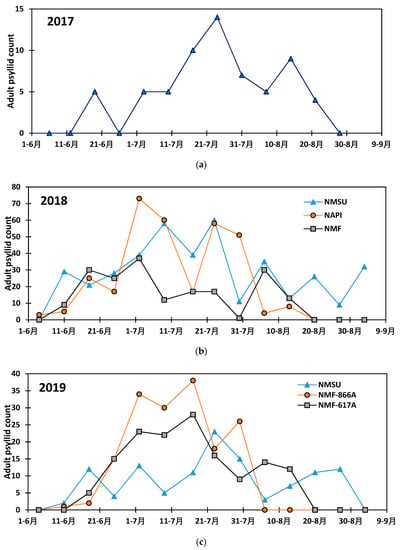
Figure 2.
Population dynamics of Bactericera cockerelli in the study area during the (a) 2017, (b) 2018, and (c) 2019 potato growing seasons.
Across the study area, adult B. cockerelli appears at the beginning of June and the population increases and peaks in mid to late July and decreases toward the end of August−early September. During the 2017 growing season, B. cockerelli was collected only at the NMSU research station and the population increased from June 11 to July 24 with a peak population of 14 adults of B. cockerelli collected and decreased thereafter. After potato vine killing by the end of August, the B. cockerelli disappeared from the plot due the lack of the host potato plant. During the 2018 growing season, adults of B. cockerelli appeared at the beginning of June and the population increased and peaked in July at the NMSU field with 58 adults B. cockerelli collected a week while the peak population was found in late June early July with 73 adults B. cockerelli collected, and peak was shown in early July with 12 adults collected a week (Figure 2). However, the abundance of B. cockerelli showed a second population peak occurring in late July at NAPI farm and early August in the Navajo Mesa farm and at NMSU. During the 2019 growing season, similar population trend was observed across all three fields. As previously observed in 2017 and 2018, B. cockerelli appeared during the second week of June and its number increased up to a peak of 38 adults in one of the Navajo Mesa field, 28 adults in the second field of Navajo Mesa, and 23 adults at NMSU during the third week of July (Figure 2). The abundance of B. cockerelli decreased thereafter toward the end of August−early September which coincided with potato vine killing period.
Combining adults’ data of all fields on a two-week basis during the 2017 growing season, the first catch of adult B. cockerelli occurred during the second half of June and the population peaked during the second half of July with a total of 31 adults cached (Figure 3). During the 2018 growing season, adults appeared earlier than during the 2017 growing season. The population increased early June from 29 collected adults to 110 adults during the second half of July and decreased to 32 adults collected during the first half of September. During the 2019 growing season the population dropped as compared to the 2018 growing season B. cockerelli appeared early June and its population increased from two adults early June to 38 during the second half of July and decreased thereafter. As presented in Figure 3, the moving average of two-week period showed the B. cockerelli population peak occurring consistently during the second half of July in 2017, 2018, and 2019.
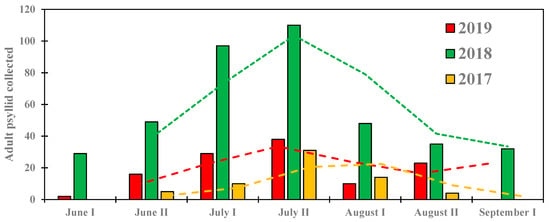
Figure 3.
Biweekly abundance of the total adults of B. cockerelli collected across all experimental fields during the 2017, 2018, and 2019 potato growing seasons.
The results of this study are in agreement with some previous studies on the populations dynamics of the potato psyllids. Munyaneza et al. [23] reported that B. cockerelli appeared late July and the population peak magnitude and timing varied with years and occurred during the period of late August to the third week of September in Yakima and Benton counties in Washington State. Seasonal variation in potato psyllid population was also reported by Goolsby et al. [16] who indicated the variation of B. cockerelli population across years in potato growing regions in Texas, Nebraska and Colorado. Similar trend was reported in Texas and New Mexico by Workneh et al. [17]. Teresani et al. [29] collected the maximum psyllid species during summer months with the different peak magnitudes occurring in July at some locations and in August at other locations in Spain and the Canary Islands. B. cockerelli appeared in Washington State and Oregon in late June and early July [6,30]. Similarly, Randon et al. [24] reported the potato field invasion by B. cockerelli during late June to Late July across the Pacific Northwest United States. The results of the present study are opposed to the findings of Randon et al. [24] who reported that B. cockerelli was not detected before mid-July and its population steadily increased throughout the potato growing season in Columbia Basin (Oregon). Horton et al. [31] also reported that B. cockerelli was in a low population from late May to late June and its number continued to increase from mid−July as the season progresses up to potato harvest in September in Washington State. Similar findings were reported by Wenninger et al. [32] in the southern Idaho. The results of the temporal variation in B. cockerelli population in the Four Corners region should aid in planning for the control of the pest as a very large acreage of table and chip potato is grown every season in the region and which is of a prime economic importance for the commercial potato growers and the small scale producers.
3.2. Impact of Air Temperature and Thermal Unit on the Abundance of Bactericera Cockerelli during the Potato Growing Season
Average air temperature during the year 2018 and 2019 is presented in Figure 4. The Figure 4a shows the cumulative heat units from January 1st to November 15th of the years 2018 and 2019. Due to technical problem, climatic parameters were not collected during a part of the year 2017 with is not considered for the analysis in this section. Air temperature increased from January to the maximum of 26 °C 28 °C at the end of July 2018 and 2019, respectively. The 2018 season was warmer than 2019 and the difference in the accumulated heat unit is shown in Figure 4b. The total heat units accumulated in 2018 was 4477 °C while the total was 4026 °C in 2019, representing a 10% decrease in the total heat units.
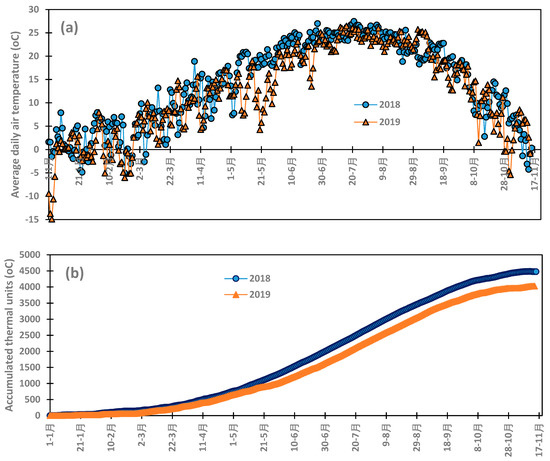
Figure 4.
Evolution of air temperature (a) and the cumulated heat units (b) from January 1st to November 15th during 2018 and 2019.
Abundance of B. cockerelli was linearly correlated to average air temperature (Figure 5a). The population of the pest increased as average air temperature increased, and the slope of the regression varied with years and was 15.17 in 2018 band 6.47 in 2019 while the coefficient of determination R2 of the correlations was 0.34 in 2018 and 0.21 in 2019. R2 values are relatively low and expressed on average the weakness of the impact of air temperature on the dynamics of the population of B. cockerelli in the Four Corners region. The 2018 and 2019 pooled data showed also positive linear relationship with air temperature with the regression slope of 12.29 and coefficient of determination R2 of 0.32. Potato psyllid appeared when average air temperature is greater than 19 °C during both potato growing seasons. The abundance of potato psyllid showed better relationship with the accumulated thermal unit compared to its relationship with average air temperature.
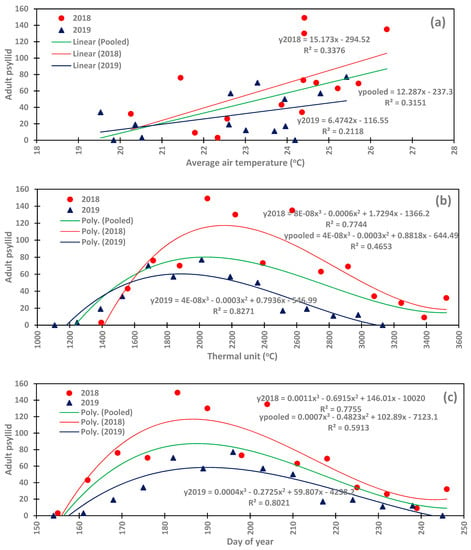
Figure 5.
Correlation between the abundance of Bactericera cockerelli and (a) average air temperature; (b) accumulated thermal unit; and (c) Julian day during 2018 and 2019.
Potato psyllid population had strong third order polynomial correlation with the accumulated thermal unit in 2018 and 2019 with the R2 values of 0.77 and 0.83 in 2018 and 2019, respectively and the pooled data also showed similar correlation with R2 value of 0.46 (Figure 5b). The lower R2 value of the pooled data correlation is due seasonal or annual variation in the abundance of the B. cockerelli. The presence of potato psyllid in the study area started with the accumulated thermal unit about 1400 °C in both 2018 and 2019. Potato psyllid population increased as the thermal unit increased and peaked at the thermal unit values of 2049 °C and 2013 °C in 2018 and 2019, respectively. The population decreased thereafter to the minimum around 3387 °C in 2018 and 3130 °C in 2019.
The population of B. cockerelli during potato growing season showed strong third order polynomial relationship with the Julian day as shown in Figure 5c. The coefficients of determination of the relationships between the dynamics of the potato psyllid population and the Julian day were 0.78 and 0.80 for the 2018 and 2019, growing seasons, respectively, while the 2018 and 2019 pooled data had a lower coefficient of determination R2 value of 0.59 due to the difference in the magnitude of the abundance of the pest during the two seasons.
The relationships developed in the study are indicative of the occurrence and the magnitude of the abundance of potato psyllid in the northwestern New Mexico. While there is a difference in the peaks, the start point was the same around the value of 1390 °C of the accumulated thermal unit. This start point may not coincide with the same Julian day from one year to the other because average air temperature usually varies with years as 2018 was warmer than 2019 (Figure 4b).
The results of the present study corroborate with the finding of Antolínez et al. [33] who reported the arrival of potato psyllid in the potato fields when the average air temperature is greater than 15 °C and the peak population occurred when air temperature was about 25 °C in Spain. Wenninger et al. [21] also correlated the population abundance of adults B. cockerelli with the accumulated thermal unit and found the population peak at 1775 °C in late August in the Treasure Valley and at 1498 °C in the Magic Valley in Idaho. Lewis et al. [34] suggested integrating accumulated thermal units into the management and control of B. cockerelli and proposed a model that integrates thermal unit to simulate the development of potato psyllid infestation.
3.3. Bactericera Cockerelli Infection by Zebra Chip Pathogen (Candidatus Liberibacter Solanacearum)
The infection rating of Bactericera cockerelli by zebra chip disease pathogen Candidatus Liberibacter solanacearum (Lso) was revealed as low during the study period (Figure 6). The infected adults of the potato psyllid were collected during the population peak period around mid-July to late July. During the 2017 monitoring period, there were four adults B. cockerelli infected with the pathogen over a total of 64 adults of potato psyllid collected and which represent 6.25% of the total adults collected during the 2017 season. During the 2018 monitoring period, a total of 912 adult B. cockerelli were collected and only two adults were test positive to Lso, representing 0.22% of infected adults. During the 2019 monitoring season, there were four adults B. cockerelli tested positive to Lso over a total of 426. This rating represents 0.94% of the total adults B. cockerelli collected during the 2019 season. These results are in agreement with those of similar studies conducted across the United States. Workneh et al. [17] reported as low as 11 adults of B. cockerelli tested positive over about 1800 B. cockerelli collected during four-year study period across Texas and at Farmington, NM. Goolsby et al. [16] reported infection rating of B. cockerelli by Lso below 8% of the total trapped B. cockerelli, and which varied with years and locations across Texas, Kansas, Colorado, and Nebraska. The percentage of the total adult B. cockerelli tested positive if Lso was below 1% in Kansas and Nebraska while it greatly varied across Texas with higher infection rating [16]. Wenninger et al. [35] also reported a low incidence of Candidatus Liberibacter solanacearum over four years while a high infection rate of 23% was shown in one year during the 2013−2017 study. The results of this study should be considered for decision making regarding timely pest management as Goolsby et al. [16] reported a strong positive correlation between the infected adult psyllids and zebra chip disease incidence in harvested potato tubers. A previous study by Workneh et al. [17] demonstrated that the Southern B. cockerelli haplotype (lower Rio Grande Valley, Texas) are the dominant one monitored in Farmington, NM during the 2014−2017 period. Further, with the high infection rating of the B. cockerelli in Texas [16], there should be a rigorous surveillance and monitoring program for the potato psyllid control to reduce the incidence of zebra chip disease in the commercial potato field at NAPI and Navajo Mesa farms and in the small-scale farms. While Walker et al. [36] reported an economic threshold of three adults of potato psyllid per sticky trap, Randon et al. [24] indicated that there is no population economic threshold for the potato psyllid and action should be taken once the pest is detected in the field and Munyaneza [2] indicated that the potato psyllid controls start at plant emergence in the Southwest due to the presence of the pest at crop emergence.
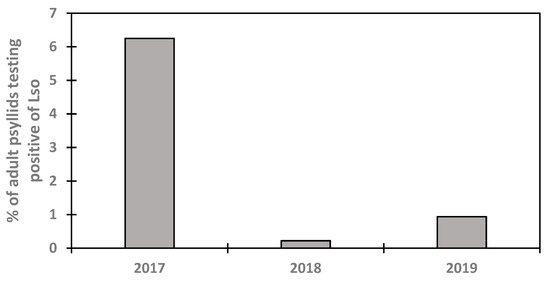
Figure 6.
Percentage of infected adult psyllids collected in sticky traps during the 2017−2019 period.
4. Conclusions
The population dynamics of the potato psyllid (Bactericera cockerelli) were monitored and the infections of adults were tested for zebra chip disease pathogen Candidatus Liberibacter solanacearum that puts the potato production at risk of the disease in northwestern New Mexico. Overall, adults of potato psyllid started infesting the potato farms in early June and the pest population peaked during the second half of July, with a second les important peak thereafter. B. cockerelli population showed strong third order polynomial relationships with the accumulated thermal unit and Julian days with a high coefficient of determination R2 value for each year ≥0.77. Meanwhile, the pooled data showed lower R2 due to seasonal variation in the abundance of the pest. A Candidatus Liberibacter solanacearum infection test revealed a low incidence of the pathogen varying from 0.22% to 6.25% of adult B. cockerelli and the pathogen is present during the population peak of B. cockerelli. While the results of this study might help commercial potato growers and small scale growers in pest management, further study must be conducted to evaluate the zebra chip disease and develop an economic threshold and pest management program to reduce the economic impact of the disease on potato production.
Author Contributions
C.H. and K.D. conceived and designed the experiments; C.H., S.B., K.D. and S.A. performed the experiments; K.D., K.L., S.A., M.O., and K.K. contributed reagents/materials/graphic tools and plot of data; K.D., K.L., K.K., M.O. and S.A. wrote the paper. All authors have read and agreed to the published version of the manuscript.
Funding
This research was funded by POTATOES USA, grant GR0006097.
Acknowledgments
We completed this work with the support of Potatoes USA, New Mexico State University (NMSU) and the Agricultural Science Center at Farmington and all the staff.
Conflicts of Interest
Charles Higgins is currently an employee of Higgins Farms Inc., Farmington, NM, USA. Shantel Begay is currently an employee of Wilbur-Ellis Co., Farmington, NM, USA. Komlan Koudahe is currently an employee of ADA Consulting Africa, Lomé, Togo. The other authors declare no conflict of interest.
References
- Rosson, P.; Niemeyer, M.; Palma, M.; Ribera, L. Economic Impacts of Zebra Chips on the Texas Potato Industry; Center for North American Studies, Department of Agricultural Economics, Texas A&M University: College Station, TX, USA, 2006. [Google Scholar]
- Munyaneza, J.E. Zebra chip disease of potato: Biology, epidemiology, and management. Am. J. Potato Res. 2012, 89, 329–350. [Google Scholar] [CrossRef]
- Sengoda, V.G.; Munyaneza, J.E.; Crosslin, J.M.; Buchman, J.L.; Pappu, H.R. Phenotypic and etiological differences between psyllid yellows and zebra chip diseases of potato. Am. J. Potato Res. 2010, 87, 41–49. [Google Scholar] [CrossRef]
- Munyaneza, J.E.; Crosslin, J.M.; Upton, J.E. Association of Bactericera cockerelli (Homoptera: Psyllidae) with “zebra chip”, a new potato disease in southwestern United States and Mexico. J. Econ. Entomol. 2007, 100, 656–663. [Google Scholar] [CrossRef]
- Munyaneza, J.E.; Goolsby, J.A.; Crosslin, J.M.; Upton, J.E. Further evidence that zebra chip potato disease in the lower Rio Grande Valley of Texas is associated with Bactericera cockerelli. Subtrop. Plant. Sci. 2007, 59, 30–37. [Google Scholar]
- Crosslin, J.M.; Hamm, P.B.; Eggers, J.E.; Rondon, S.I.; Sengoda, V.G.; Munyaneza, J.E. First report of zebra chip disease and “Candidatus Liberibacter solanacearum” on potatoes in Oregon and Washington. Plant. Dis. 2012, 96, 452. [Google Scholar] [CrossRef]
- Butler, C.D.; Trumble, J.T. The potato psyllid, Bactericera cockerelli (Sulc) (Hemiptera: Triozidae): Life history, relationship to plant diseases, and management strategies. Terr. Arthropod Rev. 2012, 5, 87–111. [Google Scholar] [CrossRef]
- Vereijssen, J.; Grant, R.G.; Phyllis, G.W. Bactericera cockerelli (Hemiptera: Triozidae) and Candidatus Liberibacter solanacearum in Potatoes in New Zealand: Biology, Transmission, and Implications for Management. J. Integr. Pest. Manag. 2018, 9, 1–21. [Google Scholar] [CrossRef]
- Strand, L.L. Integrated Pest Management for Potatoes in the Western United States; University of California-Agriculture and Natural Resource: Oakland, CA, USA, 2006. [Google Scholar]
- Nelson, R.J.; Denlinger, D.L.; Somers, D.E. Photoperiodism: The Biological Calendar; Oxford University Press: New York, NY, USA, 2010. [Google Scholar] [CrossRef]
- Goolsby, J.A.; Adamczyk, J.; Bextine, B.; Lin, D.; Munyaneza, J.E.; Bester, G. Development of an IPM program for management of the potato psyllid to reduce incidence of zebra chip disorder in potatoes. Subtrop. Plant. Sci. 2007, 59, 85–94. [Google Scholar]
- Martin, N.A. Host plants of the potato/tomato psyllid: A cautionary tale. Weta 2008, 35, 12–16. [Google Scholar]
- Lin, H.; Doddapaneni, H.; Munyaneza, J.E.; Civerolo, E.L.; Sengoda, V.G.; Buchman, J.L.; Stenger, D.C. Molecular characterization and phylogenetic analysis of 16S rRNA from a new species of “Candidatus Liberibacter” associated with Zebra chip disease of potato (Solanum tuberosum L.) and the potato psyllid (Bactericera cockerelli Sulc). J. Plant Pathol. 2009, 91, 213–217. [Google Scholar]
- Crosslin, J.M.; Bester, G. First report of Candidatus Liberibacter psyllaurous in zebra chip symptomatic potatoes from Cal. Plant. Dis. 2009, 93, 551. [Google Scholar] [CrossRef] [PubMed]
- Wen, A.; Mallik, I.; Alvarado, V.Y.; Pasche, J.S.; Wang, X.; Li, W.; Levy, L.; Lin, H.; Scholthof, H.B.; Mirkov, T.E.; et al. Detection, distribution, & genetic variability of ’Candidatus Liberibacter’ species associated with zebra complex disease of potato in North America. Plant. Dis. 2009, 93, 1102–1115. [Google Scholar] [PubMed]
- Goolsby, J.A.; Adamczyk, J.J.; Crosslin, J.M.; Troxclair, N.N.; Anciso, J.R.; Bester, G.G.; Bradshaw, J.D.; Bynum, E.D.; Carpio, L.A.; Henne, D.C.; et al. Seasonal population dynamics of the potato psyllid (Hemiptera: Triozidae) and its associated pathogen “Candidatus Liberibacter solanacearum” in potatoes in the southern great plains of North America. J. Econ. Entomol. 2012, 105, 1268–1276. [Google Scholar] [CrossRef] [PubMed]
- Workneh, F.; Paetzold, L.; Silva, A.; Johnson, C.; Rashed, A.; Badillo-Vargas, I.; Gudmestad, N.C.; Rush, C.M. Assessments of Temporal Variations in Haplotypes of ‘Candidatus Liberibacter solanacearum’ and Its Vector, the Potato Psyllid, in Potato Fields and Native Vegetation. Environ. Entomol. 2018, 47, 1184–1193. [Google Scholar] [CrossRef] [PubMed]
- Rondon, S.I.; Hamm, P.B. Essential Information about Zebra Chip (ZC) in the Columbia Basin: Identification, Late Season Control, and Storage; Oregon State University: Corvallis, OR, USA, 2011. [Google Scholar]
- Crosslin, J.M.; Olsen, N.; Nolte, P. First report of zebra chip disease and “Candidatus Liberibacter solanacearum” on potatoes in Idaho. Plant. Dis. 2012, 96, 453. [Google Scholar] [CrossRef] [PubMed]
- Henne, D.C.; Anciso, J.; Bradshaw, J.; Whipple, S.; Carpio, L.; Schuster, G.; Richmond, J.; Walker, S.; Porter, P.; Barrett, S.; et al. Overview of the 2011–2012 potato psyllid area wide monitoring program. In Proceedings of the 14th Annual SCRI Zebra Chip Reporting Session, Portland, OR, USA, 9–12 November 2012. [Google Scholar]
- Wenninger, E.J.; Carroll, A.; Dahan, J.; Karasev, A.V.; Thornton, M.; Miller, J.; Nolte, P.; Olsen, N.; Price, W. Phenology of the potato psyllid, Bactericera cockerelli (Hemiptera: Triozidae), and “Candidatus Liberibacter solanacearum” in commercial potato fields in Idaho. Environ. Entomol. 2017, 46, 1179–1188. [Google Scholar] [CrossRef]
- Horton, D.R.; Munyaneza, J.E.; Swisher, K.D.; Echegaray, E.; Murphy, A.F.; Rondon, S.I.; Sengoda, V.G.; Neven, L.G.; Jensen, A.S. What is the source of potato psyllids colonizing Washington, Oregon, and Idaho potato fields? Potato Prog. 2014, 14, 1–6. [Google Scholar]
- Munyaneza, J.E.; Buchman, J.L.; Crosslin, J.M. Seasonal occurrence and abundance of the potato psyllid, Bactericera cockerelli, in south central Washington. Am. J. Potato Res. 2009, 86, 513–518. [Google Scholar] [CrossRef]
- Rondon, S.; Schreiber, A.; Jensen, A.; Hamm, P.; Munyaneza, J.E.; Nolte, P.; Olsen, N.; Wenninger, E.; Henne, D.; Wohleb, C.; et al. Potato Psyllid Vector of Zebra Chip Disease in the Pacific Northwest: Biology, Ecology, and Management; Oregon State University Extension Service: Corvallis, OR, USA, 2017. [Google Scholar]
- Swisher, K.D.; Henne, D.C.; Crosslin, J.M. Identification of a Fourth Haplotype of Bactericera cockerelli (Hemiptera: Triozidae) in the United States. J. Insect Sci. 2014, 14. [Google Scholar] [CrossRef]
- Gharalari, A.H.; Nansen, C.; Lawson, D.S.; Gilley, J.; Munyaneza, J.E.; Vaughn, K. Knockdown mortality, repellency, and residual effects of insecticides for control of adult Bactericera cockerelli (Hemiptera: Psyllidae). J. Econ. Entomol. 2009, 102, 1032–1038. [Google Scholar] [CrossRef]
- Martin, N.A. Tomato potato psyllid—Bactericera cockerelli. In Interesting Insects and other Invertebrates; Manaaki Whenua-Landcare Research: Hamilton, New Zealand, 2016. [Google Scholar]
- Harrison, K.; Tamborindeguy, C.; Scheuring, D.C.; Herrera, A.M.; Silva, A.; Badillo-Vargas, I.E.; Miller, J.C.; Levy, J.G. Differences in Zebra Chip Severity between ‘Candidatus Liberibacter Solanacearum’ Haplotypes in Texas. Am. J. Potato Res. 2019, 96, 1–86. [Google Scholar] [CrossRef]
- Teresani, G.R.; Hernández, E.; Bertolini, E.; Siverio, F.; Marroquín, C.; Molina, J.; de Mendoza, A.H.; Cambra, M. Search for potential vectors of ‘Candidatus Liberibacter solanacearum’: Population dynamics in host crops. Span. J. Agric. Res. 2015, 13, 1002. [Google Scholar] [CrossRef]
- Munyaneza, J.E. Psyllids as vectors of emerging bacterial diseases of annual crops. Southwest. Entomol. 2010, 35, 471–477. [Google Scholar] [CrossRef]
- Horton, D.R.; Cooper, W.R.; Munyaneza, J.E.; Swisher, K.D.; Echegaray, E.R.; Murphy, A.F.; Rondon, S.I.; Wohleb, C.H.; Waters, T.D.; Jensen, A.S. A new problem and old questions: Potato psyllid in the pacific northwest. Am. Entomol. 2015, 61, 234–244. [Google Scholar] [CrossRef]
- Wenninger, E.J.; Olsen, N.; Thornton, M.; Nolte, P.; Miller, J.; Karasev, A. Monitoring of potato psyllids, Candidatus Liberibacter solanacearum, and zebra chip in Idaho during the 2013 growing season. In Proceedings of the 13th Annual SCRI Zebra Chip Reporting Session, San Antonio, TX, USA, 3–6 November 2013. [Google Scholar]
- Antolínez, C.A.; Moreno, A.; Ontiveros, I.; Pla, S.; Plaza, M.; Sanjuan, S.; Palomo, J.L.; Sjölund, M.J.; Sumner-Kalkun, J.C.; Arnsdorf, Y.M.; et al. Seasonal Abundance of Psyllid Species on Carrots and Potato Crops in Spain. Insects 2019, 10, 287. [Google Scholar] [CrossRef] [PubMed]
- Lewis, O.M.; Michels, G.J.; Pierson, E.A.; Heinz, K.M. A Predictive Degree Day Model for the Development of Bactericera cockerelli (Hemiptera: Triozidae) Infesting Solanum tuberosum. Environ. Entomol. 2015, 44, 1201–1209. [Google Scholar] [CrossRef]
- Wenninger, E.J.; Dahan, J.; Thornton, M.; Karasev, A.V. Associations of the Potato Psyllid and "Candidatus Liberibacter solanacearum" in Idaho with the Noncrop Host Plants Bittersweet Nightshade and Field Bindweed. Environ Entomol. 2019, 48, 747–754. [Google Scholar] [CrossRef]
- Walker, G.P.; MacDonald, F.H.; Wright, P.J.; Puketapu, A.J.; Gardner-Gee, R.; Connolly, P.G.; Anderson, J.A. Development of Action Thresholds for Management of Bactericera cockerelli and Zebra Chip Disease in Potatoes at Pukekohe, New Zealand. Am. J. Potato Res. 2015, 92, 266. [Google Scholar] [CrossRef]
© 2019 by the authors. Licensee MDPI, Basel, Switzerland. This article is an open access article distributed under the terms and conditions of the Creative Commons Attribution (CC BY) license (http://creativecommons.org/licenses/by/4.0/).